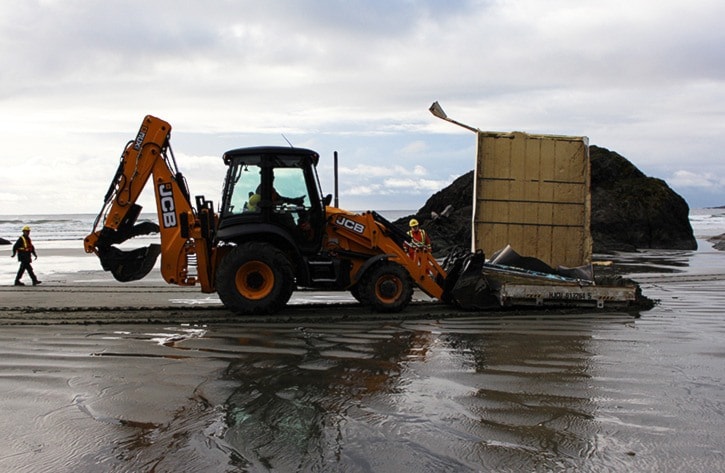A badly beaten up shipping container that had been torn apart by the West Coast's waves and rocky shorelines was removed from Long Beach Thursday morning.
The container's violent oceanic journey came to an end next to Incinerator Rock and Pacific Rim National Park staff pushed and pulled its remains off the beach with a wheel loader, leaving the structure's skeleton in the parking lot where it will be chopped up and trucked out at a later date.
Park staff plan to remove a second container discovered at nearby Combers Beach in short order.
The two containers are believed to be castaways from the cargo ship Hanjin Seattle, which was making its way from San Francisco to Seattle around Nov. 5 when heavy winds robbed it of 35 shipping containers, according to the Park's Resource Conservation Manager Renee Wissink.
“It was somewhere near the entrance of Juan de Fuca Sound and, in the weather that we had at the time, apparently 35 empty shipping containers were blown overboard and into the ocean,” Wissink told the Westerly. “Since that time, these containers or what's left of these containers because they seem to have broken up, have been arriving along the coast of Vancouver Island.”
The containers were empty but were insulated with styrofoam that has been strewn along local shores.
“Styrofoam debris from the insulation spread more widely along our beaches and headlands,” Wissink said. “The problem with styrofoam is it tends to break into smaller and smaller pieces until you get these very small pieces that potentially could be ingested by sea life or life on land.”
With 33 containers still unaccounted for, Park staff have been combing more remote areas around the Broken Group Islands and West Coast Trail.
“It's easy to find them on popular beaches where we know we've got lots of people out beachcombing on a daily basis but, the Park covers 125 kilometres of the West Coast of Vancouver Island and there's numerous pocket beaches and headlands and nooks and crannies,” Wissink said. “So far, knock on wood, they haven't found any of these containers on the West Coast Trail shores.”
He is hopeful more containers won't show up but said they're a hazard wherever they are.
“It is possible that we could receive more but my gut feeling about that is given the storms that we've had recently, probably most of them have either sank or been driven ashore somewhere,” he said. “They're not good no matter where they are. If they're floating either on or above the surface, they're a hazard to navigation. If they're on the bottom or on our beaches, they're a potential pollution hazard and public safety hazard because they're broken apart.”
He added the Park's shores are perpetual landing spots for washed up ocean waste and he hopes to see federal regulations put in place to help those who find marine debris cover the costs to remove it.
“These containers are just the latest. There's always debris coming ashore from various sources out there,” he said. “This is just one more issue of that much larger marine debris issue, which we need to tackle both nationally and internationally.”
The Park was forced to dip into its contingency coffers back in May when a derelict vessel landed on Florencia Bay and its owner failed to offer any financial support to clean it up.
“The owner didn't take any responsibility for it in the end, unfortunately,” Wissink said.
The Park has gone to its contingency coffers again to fund the removal of these latest containers and while Wissink hopes the Hanjin Seattle's owner will step up to provide assistance, he said the potential for renumeration is murky because the shipping company the vessel belongs to is under receivership.
“We're working with the Coast Guard and Transport Canada to come up with an ultimate resolution to this and that does include working with the company,” he said. “It's presently under bankruptcy protection so that is causing a bit of concern in terms of what we may get in the end.”
He added the Park can't afford to wait on the owners' of debris to clean up the mess.
“The important thing for us of course is to protect the ecological integrity of the Park and the wildlife that occurs here and we're also very concerned about the visitor experience,” he said adding Incinerator Rock is a key destination for Park visitors.
“That's probably our most popular beach this time of year, in terms of visitation, and right in the middle of that is this container. It is quite irritating for visitors to come here, go to that beach and find that portion of a container sitting there.”
The Pacific Rim chapter of the Surfrider Foundation has scheduled an emergency cleanup at Schooner Cove to tackle the containers' styrofoam debris on Saturday, Nov. 19, and anyone willing to lend a hand is encouraged to meet at Schooner's parking lot at 9:15 a.m.
“We're very appreciative of their efforts. They've been excellent at helping us out with this and past efforts,” Wissink said of Surfrider. “Surfrider's been great, but also individual citizens have all been doing their part to help us out and we really appreciate that.”
To sign up for Surfrider's cleanup, email volunteercoordinator@pacificrim.surfrider.org.
